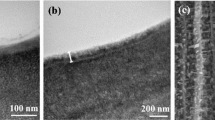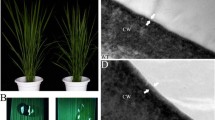Abstract
In corn seedlings (Zea mays L.) homozygous for the mutation gl5, the surface waxes are characteristically altered. In this mutant the main wax constituents (83.5%) are aldehydes while in the normal waxes alcohols predominate (62.7%). Moreover, in the normal waxes aldehydes and alcohols are made up mainly of the C32 term (99%), whereas in gl5 waxes the principal aldehyde is still C32 (90.7%) but the free alcohol composition pattern is noticeably modified. Here the predominant terms are C24, C26, and C28, with C32 representing only 16.6% of the total. The results indicate that the mutant induces a block in the synthesis of fatty alcohols while accumulating fatty aldehydes, the substrates from which the alcohols originate.
Similar content being viewed by others
References
Bianchi, A. (1978). Glossy mutants: Level of action and level of analysis. In Proceedings of the International Maize Symposium: Genetics and Breeding, Urbana, Illinois, Sept. 8–12, 1975, John Wiley and Son, New York, in press.
Bianchi, G., and Salamini, F. (1975). Glossy mutants of maize. IV. Chemical composition of normal epicuticular waxes. Maydica 201.
Bianchi, G., Avato, P., and Salamini, F. (1975). Glossy mutants of maize. VI. Chemical constituents of glossy-2 epicuticular waxes. Maydica 20165.
Bianchi, G., Avato, P., and Salamini, F. (1977). Glossy mutants of maize. VII. Chemistry of glossy-1, glossy-3 and glossy-7 epicuticular waxes. Maydica 229.
Buckner, J. S., and Kolattukudy, P. E. (1973). Specific inhibition of alkane synthesis with accumulation of very long chain compounds by dithiothreitol, and mercaptoethanol in Pisum sativum. Arch. Biochem. Biophys. 15634.
Kolattukudy, P. E. (1966). Biosynthesis of wax in Brassica oleracea: Relation of fatty acids to wax. Biochemistry 52265.
Kolattukudy, P. E. (1969). Biosynthesis of surface lipids. Science 159498.
Kolattukudy, P. E. (1970a). Biosynthesis of cuticular lipids. Ann. Rev. Plant Physiol. 21163.
Kolattukudy, P. E. (1970b). Composition of the surface lipids pea leaves (Pisum sativum). Lipids 5398.
Kolattukudy, P. E. (1970c). Plant waxes. Lipids 5259.
Kolattukudy, P. E. (1970d). Reduction of fatty acids to alcohols by cell-free preparation of Euglena gracilis. Biochemistry 91095.
Kolattukudy, P. E. (1971). Enzymatic synthesis of fatty alcohols in Brassica oleracea. Arch. Biochem. Biophys. 142701.
Kolattukudy, P. E. (ed.) (1976). Chemistry and Biochemistry of Natural Waxes, Elsevier, Amsterdam.
Kranz, Z. H., Lamberton, J. A., Murray, K. E., and Redcliffe, A. H. (1960). Sugar-cane waxes. Aust. J. Chem. 13498.
Lamberton, J. A., and Redcliffe, A. H. (1960). The chemistry of sugar-cane wax. Aust. J. Chem. 13261.
Macey, M. J. K. (1974). Wax synthesis in Brassica oleracea as modified by trichloroacetic acid and glossy mutations. Phytochemistry 131353.
Macey, M. J. K., and Barber, H. N. (1970a). Chemical genetics of wax formation on leaves of Pisum sativum. Phytochemistry 95.
Macey, M. J. K., and Barber, H. N. (1970b). Chemical genetics of wax formation on leaves of Brassica oleracea. Phytochemistry 913.
Nodskov Giese, B. (1976). Roles of the cer-j and cer-p loci in determining the epicuticular wax composition of barley seedling leaves. Hereditas 82137.
Radler, F. (1965). The surface waxes of the sultane vine. Aust., J. Biol. Sci. 181045.
Schmid, H. H. O., and Bandi, P. C. (1969). n-Triacontanol and other long-chain aldehydes in the surface lipids of plants. H.S.Z. Physiol. chem. 350462.
von Wettstein-Knowles, P. (1971). The molecular phenotypes of the eceriferum mutants. In Nilan, R. A. (ed.), II. Proc. 2nd Int. Barley Genet. Symp., WSU Press, Pullman, Wash., pp. 146–193.
von Wettstein-Knowles, P. (1972). Genetic control of β-diketone and hydroxy-β-diketone synthesis in epicuticular waxes of barley. Planta 106113.
von Wettstein-Knowles, P. (1974). Gene mutation in barley inhibiting the production and use of C26 chains in epicuticular wax formation. FEBS Lett. 42187.
Author information
Authors and Affiliations
Additional information
This study was supported by funds from the Italian CNR (Rome).
Rights and permissions
About this article
Cite this article
Bianchi, G., Avato, P. & Salamini, F. Glossy mutants of maize. VIII. Accumulation of fatty aldehydes in surface waxes of gl5 maize seedlings. Biochem Genet 16, 1015–1021 (1978). https://doi.org/10.1007/BF00483751
Received:
Revised:
Issue Date:
DOI: https://doi.org/10.1007/BF00483751




